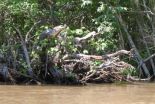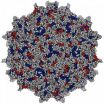(Press-News.org) LEXINGTON, Ky. (Feb. 10, 2014) — A new study led by University of Kentucky Markey Cancer Center researcher Peter Zhou shows that targeting Twist, a nuclear protein that is an accelerant of the epithelial-mesenchymal transition (EMT) program in human cells, may provide an effective approach for treating triple-negative breast cancer.
Triple-negative breast cancer has an activated EMT program, which is a process that provides cells with the increased plasticity (or flexibility) to adapt to stressed environments during embryonic development, wound healing, tissue fibrosis and metastasis. EMT provides tumor cells with stem cell-like characteristics, making them resistant to therapeutics and increasing their chances for early metastasis.
Triple-negative breast cancer in particular is associated with an aggressive clinical history, development of recurrence, distant metastasis and shorter patient survival, especially in younger women. It lacks effective targeted therapies and often displays early metastatic spread to brain and lung, sites known to be associated with an estimated 5-year survival of less than 20 percent.
Published in Cancer Cell, the study found that the nuclear protein Twist acts similarly to a virus protein. Using protein purification, Zhou's team identified that Twist interacted with a key nuclear transcription regulator BRD4. When many DNA viruses (such as papillomaviruses) enter into human "host" cells during infection, they hijack host cell machinery to replicate and synthesis their viral DNA and proteins. BRD4 is the virus's favored molecule and is often seized by DNA papillomaviruses for gene transcription during replication and growth.
Twist uses a similar strategy to recruit BRD4 to the genomic regions that are regulated by Twist. Many of these genomic regions contain oncogenes, such as those of survival proteins, growth factors and molecules that enhance cell migration and invasion. By recruiting BRD4 to these genomic regions, Twist accelerates cell growth and invasion by "waking up" the expression of these oncogenes.
Additionally, the study showed that two BRD4 inhibitors, JQ1 and MS417, can specifically disrupt the interaction of Twist with BRD4, resulting in the suppression of invasion, stem cell-like characters and tumorigenicity of triple-negative breast cancer cells.
"This finding has significant clinical ramification, because drugs that can target the Twist-BRD4 interaction provide a new hope for treating life-threatening triple-negative breast cancer," said Zhou, associate professor of molecular and cellular biochemistry at UK.
Jian Shi, a post-doctoral fellow at UK Markey Cancer Center, was the first author of this study, and other collaborators include UK Markey Cancer Center director Dr. Mark Evers and researchers Chi Wang and Haining Zhu. Previously, Zhou and his team have studied the role of the Snail complex — also known as the cellular "brake" in contrast to Twist's accelerant — in the EMT program.
INFORMATION:
New UK study shows potential for targeting aggressive breast cancers
2014-02-12
ELSE PRESS RELEASES FROM THIS DATE:
Penn Medicine: Cognitive development 'growth charts' may help diagnose and treat psychosis-risk kids
2014-02-12
PHILADELPHIA -- Penn Medicine researchers have developed a better way to assess and diagnose psychosis in young children. By "growth charting" cognitive development alongside the presentation of psychotic symptoms, they have demonstrated that the most significant lags in cognitive development correlate with the most severe cases of psychosis. Their findings are published online this month in JAMA Psychiatry.
"We know that disorders such as schizophrenia come with a functional decline as well as a concurrent cognitive decline," says Ruben Gur, PhD, director of the Brain ...
UNC study reveals potential route to bladder cancer diagnostics, treatments
2014-02-12
CHAPEL HILL, NC – Researchers at the UNC School of Medicine conducted a comprehensive genetic analysis of invasive bladder cancer tumors to discover that the disease shares genetic similarities with two forms of breast cancer. The finding is significant because a greater understanding of the genetic basis of cancers, such as breast cancers, has in the recent past led to the development of new therapies and diagnostic aids.
Bladder cancer, which is the fourth most common malignancy in men and ninth in women in the United States, claimed more than 15,000 lives last year.
The ...
Change in guidelines for Type 2 diabetes screening may lead to under-diagnosis in children
2014-02-12
Ann Arbor, Mich. – New American Diabetes Association (ADA) screening guidelines may lead to the missed diagnoses of type 2 diabetes in children, according to a new study by University of Michigan.
The research, published in the Journal of Adolescent Health, finds that both pediatric and family medicine providers who care for children are using screening tests for type 2 diabetes that may result in missed diagnoses for children, says lead author Joyce Lee, M.D., M.P.H., associate professor in U-M's Departments of Pediatrics and Communicable Diseases and Environmental ...
New imaging technique can diagnose common heart condition
2014-02-12
CHICAGO --- A new imaging technique for measuring blood flow in the heart and vessels can diagnose a common congenital heart abnormality, bicuspid aortic valve, and may lead to better prediction of complications.
A Northwestern Medicine team reported the finding in the journal Circulation. In the study, the authors demonstrated for the first time a previously unknown relationship between heart valve abnormalities, blood flow changes in the heart and aortic disease. They showed that blood flow changes were driven by specific types of abnormal aortic valves, and they were ...
Four new galaxy clusters take researchers further back in time
2014-02-12
Four unknown galaxy clusters each potentially containing thousands of individual galaxies have been discovered some 10 billion light years from Earth.
An international team of astronomers, led by Imperial College London, used a new way of combining data from the two European Space Agency satellites, Planck and Herschel, to identify more distant galaxy clusters than has previously been possible. The researchers believe up to 2000 further clusters could be identified using this technique, helping to build a more detailed timeline of how clusters are formed.
Galaxy clusters ...
Thatcher's policies condemned for causing 'unjust premature death'
2014-02-12
Dr Alex Scott-Samuel and colleagues from the Universities of Durham, West of Scotland, Glasgow and Edinburgh, sourced data from over 70 existing research papers, which concludes that as a result of unnecessary unemployment, welfare cuts and damaging housing policies, the former prime minister's legacy "includes the unnecessary and unjust premature death of many British citizens, together with a substantial and continuing burden of suffering and loss of well-being."
Speaking about the figures, Dr Scott-Samuel said: "Towards the end of the 1980s we were seeing around 500 ...
Better RNA interference, inspired by nature
2014-02-11
CAMBRIDGE, MA -- Inspired by tiny particles that carry cholesterol through the body, MIT chemical engineers have designed nanoparticles that can deliver snippets of genetic material that turn off disease-causing genes.
This approach, known as RNA interference (RNAi), holds great promise for treating cancer and other diseases. However, delivering enough RNA to treat the diseased tissue, while avoiding side effects in the rest of the body, has proven difficult.
The new MIT particles, which encase short strands of RNA within a sphere of fatty molecules and proteins, silence ...
University of Tennessee study finds crocodiles climb trees
2014-02-11
When most people envision crocodiles, they think of them waddling on the ground or wading in water—not climbing trees. However, a University of Tennessee, Knoxville, study has found that the reptiles can climb trees as far as the crowns.
Vladimir Dinets, a research assistant professor in the Department of Psychology, is the first to thoroughly study the tree-climbing and -basking behavior. The research is published in the journal Herpetology Notes and can be found at http://bit.ly/Myi8yr.
Dinets and his colleagues observed crocodile species on three continents—Australia, ...
Caltech-developed method for delivering HIV-fighting antibodies proven even more promising
2014-02-11
In 2011, biologists at the California Institute of Technology (Caltech) demonstrated a highly effective method for delivering HIV-fighting antibodies to mice—a treatment that protected the mice from infection by a laboratory strain of HIV delivered intravenously. Now the researchers, led by Nobel Laureate David Baltimore, have shown that the same procedure is just as effective against a strain of HIV found in the real world, even when transmitted across mucosal surfaces.
The findings, which appear in the February 9 advance online publication of the journal Nature Medicine, ...
The content of our cooperation, not the color of our skin
2014-02-11
It's widely acknowledged that a common threat unites people. Individuals who were previously separated by social class, race or ethnicity come together, forming new cooperative alliances to defeat a common enemy. But does it take an external threat — an attack like Pearl Harbor or 9/11 — to make these social divisions melt away?
A study by behavioral scientists at UC Santa Barbara demonstrates that peaceful cooperation has the same effect as intergroup conflict in erasing social boundaries connected to race. Their findings appear today in the journal PLOS ONE.
"Evolution ...




